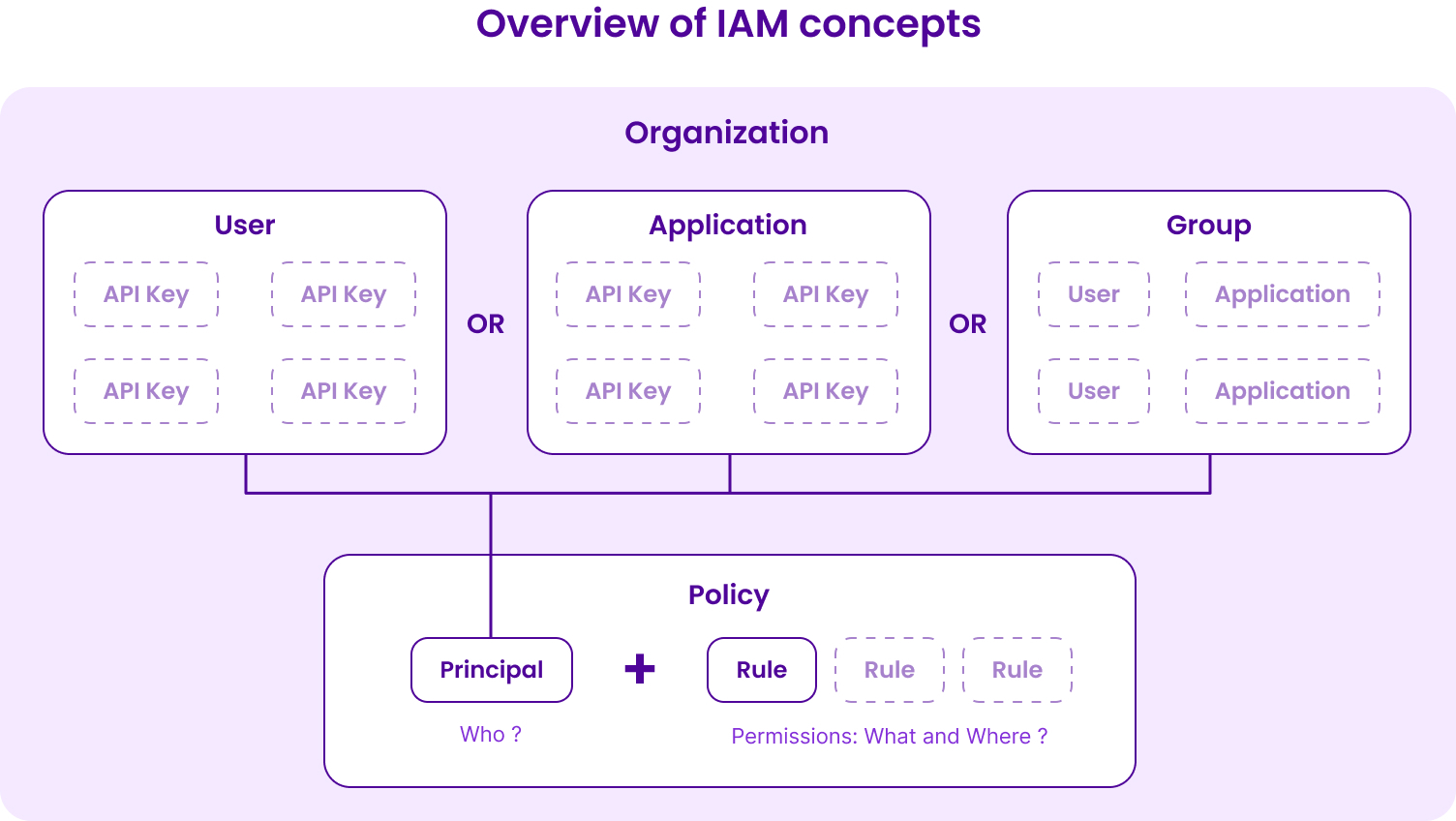IAM - Concepts

The diagram above shows how different IAM concepts mentioned on this page interact with one another.
Account
A user account refers to a human who owns a Scaleway account. Your account bears your personal information and authentication methods required to access the Scaleway console. When you create your Scaleway account, an Organization is automatically created with you as the designated Owner. You can also be added to an existing Organization as a Member and have an account that exists only within that Organization.
Refer to the How to create an account documentation page for more information.
Application
An application (also known as an IAM application) is a non-human user in an Organization. IAM applications can be used when you want to create an API key that is not linked to a user, to give programmatic access to resources.
Note that applications cannot, by definition, have access to the Scaleway console, as they have only an API key and no account themselves (they are not accounts).
Refer to the Users, groups and applications and How to manage applications documentation pages for more information.
API key
An API key is a unique identifier, used to authenticate requests made to the Scaleway API. An API key consists of an access key and a secret key. The access key is like a unique ID or username, and is not a sensitive piece of information. The secret key is more sensitive as it is like a password to authenticate the access key.
Previously, an API key was associated with a single Scaleway Project. The API key therefore had full read/write access to all resources in that Project, and only that Project.
With the introduction of IAM, an API key is now associated with an IAM user or application. This allows fine-grained access to be defined for the IAM user bearing the API key across different Organizations, Projects, and resources.
Common Expression Language (CEL)
The Common Expression Language (CEL) is used to define expressions in conditions within an IAM policy. CEL allows you to create attribute-based logic expressions that determine whether specific permissions apply. A condition expression typically consists of one or more statements, each defining an attribute-based control rule. IAM conditions use the following CEL features: Variables, Operators, Functions, and Logical Operators. Refer to the Understanding policy conditions documentation page for a detailed description of the supported CEL features.
Conditions
A condition is an additional layer of restrictions for your rule. You can allow access to specific user agents or IP addresses, and allow actions to be performed only at certain dates and times. Conditions are defined through CEL expressions, and can be set up and configured in the Scaleway console. Refer to the Understanding policy conditions documentation page to learn how they are set up and how you can define them.
Grace period
The grace period is the time an IAM Member has to comply with the security requirements that are enforced in your Organization before their account is automatically locked. The accounts can be manually unlocked by an Owner or IAM Manager. Upon regaining access, the grace period resets, giving IAM Members another chance to meet security requirements.
Group
A group (also known as an IAM group) is a grouping of users and/or applications. Creating groups allows you to attach policies to multiple users and/or applications at the same time.
Refer to the Users, groups and applications and How to manage groups documentation pages for more information.
IAM
Identity and Access Management allows you to share access to the management of your Scaleway resources in a controlled and secure manner.
This is achieved by adding Members to your Organization, and creating policies that define in a very fine-grained way exactly what permissions they should have for which resources in which of your Projects or across your whole Organization.
Similarly, you may be added as a Member in someone else's Organization, where you will have the precise rights that they accord to you using policies.
You can also create non-human users in your Organization, called IAM applications, in order to give applications programmatic access to your Scaleway resources.
Member
You are a Member when you are added to an Organization by an Owner or user with IAM Manager permissions. Members exist only within the specific Organizations in which they are created. This is Scaleway's method for allowing Organizations to have multiple users.
As a Member you are subject to complying with the security requirements in effect in your Organization. Logging into an Organization as a Member is also different from logging in as an Owner.
Organization
An Organization is made of one or several Projects. When you create your Scaleway account, an Organization is automatically created, of which you are the Owner. You can also be added to an existing Organization as a Member.
When you create IAM rules, you can set their scope at Organization level. This means you can give access to features managed at Organization level, like billing and IAM, to users, applications, and groups in your Organization.

Organization ID
The Organization ID identifies the Organization created with your account. It can be found on your Organization Settings page. You can click the Copy ID button next to the Organization name to do so.
Owner
You are the Owner of the Organization that is created with your Scaleway account. Owners have full rights and access to all resources and features in their Organization. See also Member.
Permission
A permission is a granular right, which is checked to determine whether to give access to an API endpoint. Permissions are grouped into permission sets to facilitate access management within policies.
Permission set
Permission sets are the main components of IAM rules. They consist of sets of one or multiple permissions.
Permission set names contain descriptions that clearly explain their purpose. For example, a permission set that grants access to all actions you can perform on Instances is called: InstancesFullAccess.
Permissions sets (e.g.InstanceReadAccess) and their scope (e.g. "on Project A only") make up IAM rules, which define the access rights that a principal (user, group, or application) should have.
Refer to the Permission sets reference page for an extensive list of the available permission sets.
Policy
Policies control user rights by defining one or more rules to apply to the attached principals (users, groups, or applications). A policy rule has two parts: permission set, scope and conditions.
For each policy rule, you specify one or more permission sets (e.g. "list all Instances") and their scope (e.g. "on Project A only"). This therefore defines the actions that the principles can carry out on resources within the scope.
Refer to the Understanding IAM Policies and the How to manage a policy documentation pages for more information.
Preferred Project
You can carry out actions on Scaleway Object Storage resources either via the Scaleway console, or via a third-party API or CLI, such as the AWS CLI, MinIOClient or Rclone. While the Scaleway console gives you the option to specify the Scaleway Project to carry out your Object Storage actions in, this option is not available via third-party API/CLI tools. These tools are based on a standard Amazon S3 programming interface, which does not accept Project ID as a parameter. Therefore, when you create a Scaleway API key with IAM, you are prompted to specify the API key's preferred Project for Object Storage. This API key will always use this Project when carrying out Object Storage actions via any API/CLI. See our page on using API keys with Object Storage for more information.
Principal
A principal is the target of a policy. They acquire the rights and permissions defined in the policy. A principal can be an IAM user, an IAM application or an IAM group. Each policy can have a maximum of one principal attached to it.

Project
Projects are groupings of Scaleway resources. Every Scaleway Organization has a default Project, and you can create new projects if necessary. By grouping resources into Projects, you can then define access differently for each Project.
For example, if IAM users within your Organization are working on building two different systems with Scaleway resources, you can group the resources for each system into different Projects. This then allows you to restrict IAM users' access to only the Project they are working on. It also facilitates the separation of billing between Projects.
Refer to the How to create a Project documentation page for more information.
Resource
A Scaleway resource is either a product or a feature in the Scaleway Ecosystem. Examples of resources include Instances, Private Networks, Kubernetes Kapsule and Flexible IPs, to name a few.
Rule

A rule (also known as an IAM rule) is the part of a policy that defines the permissions of the policy's principal, and the scope of these permissions. A policy can have one or many rules. Each rule consists of:
- A scope, which defines where the permission sets should apply. At Scaleway, a scope can be at Project or Organization level.
- Projects group your Scaleway resources (e.g. Instances, Object Storage buckets, Managed Databases etc.) together. An Organization may have many Projects, or just one default Project. If you choose to define scope at Project level, you can select one, many, or all Projects. When you then define the permission sets for this scope, you can give access to different resources within the Project(s).
- An Organization is made of one or several Projects. Billing, IAM, Project management and support are all managed at Organization level, so choose the Organization scope to give access to these features.
- One or more permission sets (e.g. "list all Instances"). A permission set consists of one or multiple permissions to perform actions on resources or features. Each permission set has a clear description, e.g.
InstancesFullAccess,InstancesReadOnly,DatabaseFullAccess,BillingReadOnly. - (Optional) One or more IAM conditions - defined in Common Expression Language (CEL) expressions.
Scope
A scope defines where permission sets should apply within a policy. At Scaleway, a scope can be at Project or Organization level.
Tags
Tags are key/value pairs that help you organize your users.
User
A user (also known as an IAM user) is a human user in an Organization. They can be of two types:
- Owner: You are the Owner of the Organization that was created with your account.
- Member: You are a Member when you are added to an Organization by an Owner or user with IAM Manager permissions. Members exist only within the specific Organizations in which they are created.
Within each Organization, different IAM users can have different rights (defined through policies) to perform actions on resources.
Refer to the Users, groups and applications reference page for more information.